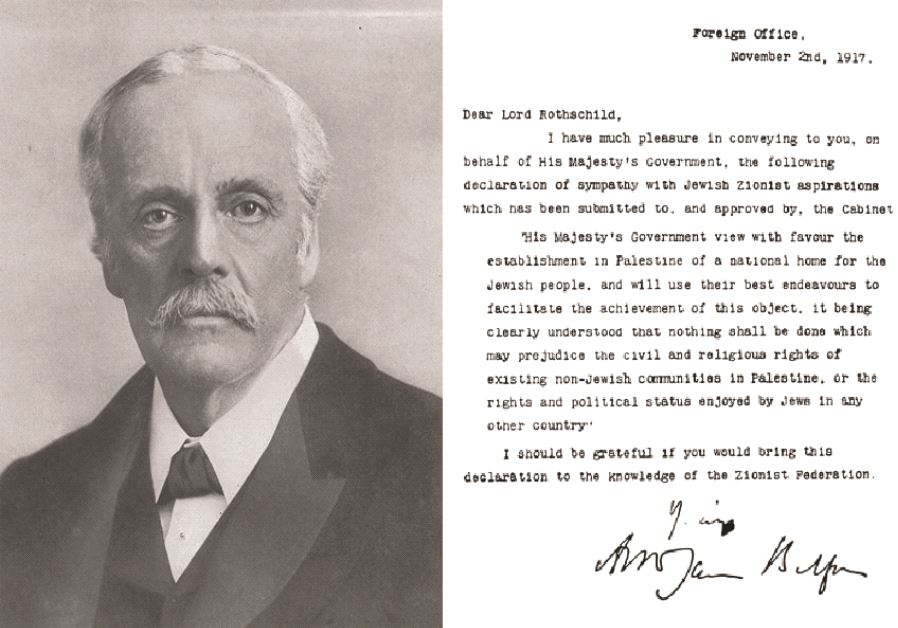Article1
The Balfour Declaration: Origins and Impact
BICOM
1st November 2016
Key points:
• Zionism, the name given to the national liberation movement of the Jewish people, emerged in Europe at the end of 19th century and called for the establishment of a Jewish homeland in the Land of Israel / Palestine. By 1917, when the Balfour Declaration (the Declaration) was published, Zionism had cross-party support in Britain as well as government backing in France, America, and other countries, while the pending defeat of the Ottoman Empire – which had controlled that geographic area for the previous four hundred years – provided an opportunity for British politicians to translate their ideological support for Zionism into practice. In that period, the Zionist movement’s call for statehood was but one of many nationalist movements – such as the Arab, Turkish, Armenian, and Kurdish – which saw the collapse of empires as an opportunity to achieve self-determination.
• The Declaration neither signalled the start of a Jewish return to the Land of Israel / Palestine nor mass immigration to it. Jews had enjoyed a continuous presence in the area for centuries before the destruction of the Second Jewish Temple in 70 CE, and by the time of the Declaration approximately 80,000- 90,000 Jews already lived in Palestine without the assistance of any external power.
• Despite opposition among many locals to Jewish immigration, some Middle Eastern leaders welcomed Zionism. As Emir Faisal ibn Husain, leader of the Arab delegation at the Paris Peace Conference wrote, the Arabs “look with the deepest sympathy on the Zionist movement” seeing it as helping their own people’s quest for self-determination.
• The Declaration itself was not a legal document but the policy it expressed, the establishment of a Jewish national home in Palestine, became binding in international law following the 1920 San Remo Conference, and the 1922 British Mandate from the League of Nations. As the Mandate drew to a close, the international legitimacy of Jewish statehood was further strengthened by UN General Assembly (UNGA) Resolution 181 – which recommended partitioning Mandatory Palestine into separate Jewish and Arab states – and reinforced by the State of Israel’s acceptance into the family of nations following its 1948 War of Independence.
• While the Declaration constituted an important component in facilitating Jewish immigration and creating the legal basis for the establishment of the State of Israel, it did not make such a homeland inevitable. In fact, primarily motivated by an attempt to satisfy Arab opposition to Zionism, British White Papers in the 1920s and 1930s severely limited Jewish immigration and threatened the viability of Jewish statehood. Any analysis of Britain’s role in the establishment of Israel should thus include both the Declaration – which encouraged Jewish immigration – and the numerous White Papers which restricted it.
• Britain’s role in the Middle East in the decades following the First World War was highly significant. But the history of the Declaration, the years of the British Mandate and the establishment of the State of Israel are complex and any assessment of Britain’s role needs to take that into consideration.

Israeli PM Benjamin Netanyahu standing with British Foreign Secretary Boris Johnson in the room in London’s Foreign Office where Arthur Balfour signed his famous 1917 declaration. February 6, 2017 (Facebook)
Introduction
The Balfour Declaration was the British government’s pledge to help the Jewish community build a national home in Palestine and took the form of a letter penned on 2 November 1917 by British Foreign Minister Lord Balfour to Lord Rothschild, then serving as the honorary president of the Zionist Federation of Great Britain and Ireland. In it, Balfour wrote that “His Majesty’s Government view with favour the establishment in Palestine of a national home for the Jewish people, and will use their best endeavours to facilitate the achievement of this object, it being clearly understood that nothing shall be done which may prejudice the civil and religious rights of existing non-Jewish communities in Palestine or the rights and political status enjoyed by Jews in any other country.”
• Controversy continues to surround the issue almost 100 years on, with supporters of Israel celebrating it and Palestinians viewing it as a criminal act. The Palestine Liberation Organisation (PLO) recently raised the idea of suing the British government, and a year-long campaign has been formally launched calling on Britain to atone for what is described as the “big crime Britain committed against the Palestinian people”. In July 2016, Palestinian Authority (PA) Minister Riyad al-Malki told Arab League leaders that the Declaration “gave people who don’t belong there [the Jews] something that wasn’t theirs”.
• Historians have offered numerous reasons to explain the issuance of the Declaration. These range from trying to secure British control over a strategically important area near the Suez Canal; preventing the German government from establishing its own relationship with the Zionist movement; the hope that the Zionist movement in Russia would persuade their government to remain on the Allies’s side in the First World War; Prime Minister David Lloyd George’s personal belief that the Jews could provide better governance than the Arab inhabitants, and his religious belief that facilitating a Jewish return to the Holy Land was following God’s plan; the diplomatic activity and skill of Zionist leader Chaim Weizmann; and the argument that wartime Britain and post-war Zionism shared identical interests and saw the Declaration as the “stepping stone” each needed to achieve their aims.
• Moving beyond the historical debate about motivations, this paper analyses the Declaration in its historical context, critically assessing its significance, and evaluating the extent to which it set the foundations for the establishment of the State of Israel in 1948.
The Ottoman Empire’s defeat and Allied support for Zionism
• The role of British as well as Australian and New Zealand (ANZAC) military forces in capturing Palestine from the Ottomans was a key factor as to why the British, rather than another country, publicly declared their support for a Jewish national home in Palestine. However the establishment of a Jewish homeland in Palestine was not solely a British policy but was also clearly supported by policy-makers from France, Italy, Russia and the US.
• France was the first of the Allied powers to recognise the Jews as a distinct nationality with French Foreign Minister Jules Cambon writing to Zionist leader Nahum Solokow in June 1917 that “it would be a deed of justice and of reparation to assist by the protection of the Allied Powers, in the renaissance of the Jewish nationality in that Land from which the people of Israel were exiled so many centuries ago”. In October 1917, US President Woodrow Wilson also expressed his support for Zionism, approving a draft text of the Declaration which he saw as a natural fit to his “New Diplomacy” that stressed national selfdetermination and democratic governance. In 1922 US Congress adopted a resolution declaring that a “national home for the Jewish people” be established in Palestine.
• Within Britain, it was the Labour Party that first publicly supported the Jewish return to Palestine. Three months prior to the Declaration, the Party’s new post war guidelines stated that “Palestine should be set free from the harsh and oppressive government of the Turk, in order that this country may form a Free State, under international guarantee, to which such of the Jewish people as desire to do so may return, and may work out their salvation free from interference by those of alien race or religion”. Moreover, on the eve of the San Remo Conference, the Labour Party neutralised attempts by left-wing groups within the Party to identify Zionism with British imperialism by giving its unqualified backing to Zionism. In a letter to Lloyd George, the Labour Party urged acceptance of the Mandate for Palestine “with a view of its being reconstituted as the national home of the Jewish people”.
• The Ottoman Empire (of which Palestine was a part) entered and was subsequently defeated in the First World War, which allowed Britain to change its rhetorical sympathy for Zionism towards active support for it. At that time, the Zionist movement’s call for statehood was one of many nationalist movements – such as the Arab, Turkish, Armenian, and Kurdish – who saw the end of empires as an opportunity to achieve selfdetermination in their own homelands.
Palestine before and after the First World War
• The Declaration neither signalled the start of a Jewish return to the Land of Israel / Palestine nor mass immigration to it. Jews had enjoyed a continuous presence in the area for centuries before the destruction of the Second Jewish Temple in 70 CE and even after much of the population was expelled in the first and second century by the Romans, Jews remained in the land and achieved major cultural achievements, such as the compilation of the fourth-century Jerusalem Talmud, and the establishment of Tzfat (Safed) as a centre for Jewish mystical tradition in the 16th century.
• While the Land of Israel and a return to Zion had always maintained its centrality in Jewish ritual and liturgy, modern day political Zionism which called for the establishment of a Jewish homeland and independent Jewish life in the land of Israel emerged in Europe in the late 19th century, inspired by other nations’ struggles for independence and as a response to persecution. Driven by waves of pogroms in the late 19th and early 20th centuries, which killed over 60,000 Jews from 1881 to 1921, European Jews began immigrating to the area in significant numbers in the 1880s, with most settling in Jerusalem – which became a Jewish majority city – and smaller communities in Tzfat, Tiberias, Hebron and Jaffa. By 1914, 80,000-90,000 Jews – approximately 8-10 per cent of the total population – lived in Palestine without the assistance of any international state or sponsor. These Jewish immigrants were legal migrants in the same way that 120,000 Jews legally migrated from Eastern Europe to the UK between 1880-1914, and they lawfully and openly bought land – much of it barren wasteland uncultivated by local Arab farmers – from absentee land owners (virtually all of the Jezreel Valley was purchased by Jews from only two people – the Turkish Sultan and a banker in Syria).
• Despite opposition among some locals to Jewish immigration, Zionism was not inherently antithetical to the Arab leadership, and some viewed it as helping their own quest for self-determination. The clearest evidence of Arab understanding for Zionism appears in the Weizmann-Faisal Agreement signed in London in 1919 on the eve of the Post-First World War Paris Peace Conference between Chaim Weizmann and Emir Faisal ibn Husain, the leader of the Arab delegation to the Conference. The Agreement’s preamble stated the “racial kinship and ancient bonds existing between the Arabs and the Jewish people” as well as the realisation that “the surest means of working out the consummation of their natural aspirations is through the closest possible collaboration in the development of the Arab State and Palestine”. Furthermore, the Agreement echoed the aims of the Declaration whereby each party committed all measure “to encourage and stimulate immigration of Jews into Palestine on a large scale”. In a subsequent letter to Felix Frankfurter, President of the Zionist Organisation of America, Faisal wrote that: “The Arabs, especially the educated among us, look with the deepest sympathy on the Zionist movement… We are working together for a reformed and revived Near East, and our two movements complete one another. The Jewish movement is national and not imperialist. Our movement is national and not imperialist… Indeed I think that neither can be a real success without the other.”
The Declaration in international legal context
• The Declaration itself was not a legal document but the policy it expressed, the establishment of a Jewish national home in Palestine, became binding in international law following the San Remo Conference, and the British Mandate from the League of Nations.

The 1920 San Remo Conference, which turned the Declaration into a legal commitment.
• The San Remo Conference, a meeting of the Allied Supreme Council following the First World War transformed the Declaration into a legal commitment. The Conference agreed to create a Mandatory power within Palestine that “should be responsible for putting into effect the declaration originally made on November 2nd, 1917, by the Government of His Britannic Majesty, and adopted by the said Powers, in favour of the establishment in Palestine of a national home for the Jewish people”. Naming the Jewish people as the cestui que trust to Palestine and basing the future administration of the country upon the fulfilment of the Declaration was a highly significant step towards future sovereignty and similar to the way in which the inhabitants of Iraq, Jordan and Syria received their sovereignty.
• In 1922, the Council of the League of Nations legally confirmed Britain as the Mandatory power for Palestine, and stated that “the Mandatory shall be responsible for placing the country under such political, administrative and economic conditions as will secure the establishment of the Jewish national home,” and that “an appropriate Jewish agency shall be recognised as a public body for the purpose of advising and co-operating with the Administration of Palestine in such economic, social and other matters as may affect the establishment of the Jewish national home”. The Council also provided “recognition…to the historical connection of the Jewish people with Palestine and to the grounds for reconstituting their national home in that country”.
• International legal recognition of a Jewish state in Mandatory Palestine was reinforced following the end of the Second World War when the British government turned the question of the future of the country over to the UN, which subsequently established the United Nations Special Committee on Palestine (UNSCOP). The Committee recommended the partition of Palestine into separate Jewish and Arab states, with Jerusalem under international control. On 29 November 1947, the UNGA voted in favour of Resolution 181, to approve the UNSCOP plan, by 33 votes to 13.
• While the Jewish Agency, representing the Jews of Palestine, accepted the plan, the Arab Higher Committee, the Palestinian Arabs’ political representatives, rejected it and Palestinian guerrilla forces began attacking Jewish communities. As the British Mandate formally ended on 14 May 1948 and David Ben-Gurion declared the establishment of the State of Israel in line with UN resolution 181, the country was in a state of internecine violence and was was invaded by several neighbouring Arab countries. In March 1949, UN Security Council Resolution 69 voted 9 to 1 in favour of UN membership for Israel while in May, the UNGA Resolution 273 approved Israel’s application to the organisation by the requisite two-thirds majority.
British policy in Palestine – Did the Declaration make the creation of Israel inevitable?
• While the Declaration constituted an important component in building the legal basis for the establishment of the State of Israel as a homeland for the Jewish people, it did not make such a homeland inevitable and subsequent actions by Britain – motivated by an attempt to balance competing commitments to Palestinian Jews and Arabs – actually threatened its viability.
• Balfour himself had interpreted the declaration as ultimately advancing Jewish sovereignty and statehood. In published minutes of a 31 October 1917 War cabinet meeting he wrote that although the Declaration did not entail a sovereign state immediately, his believed that a Jewish sovereign state “was a matter for gradual development in accordance with the ordinary laws of political evolution”.
•However, the Declaration was followed by a series of British White Papers that modified the spirit of the Declaration commitment, restricted Jewish immigration and put Jewish statehood under threat. In 1922 the government released the Churchill White Paper, which partitioned off three-quarters of the territory of Mandatory Palestine – located east of the Jordan River – in order to create the Emirate of Transjordan (later the Kingdom of Jordan) and imposed limitations on Jewish immigration of the remaining territory. The 1930 Passfield White Paper, published after Arab riots of 1929 and later withdrawn, also recommended limiting Jewish immigration Most damaging to the hopes of establishing a Jewish homeland came with the publication the 1939 White Paper on the eve of the Second World War, at a time when Jews in Europe were most dependent on Britain upholding its legal commitment to help facilitate Jewish immigration to Palestine. The latter White Paper which, in its own words “concedes the Arab claim [for self-determination] by cancelling the Jewish claim” restricted Jewish immigration to 75,000 people over the next five years, thus abandoning one of the components in the Declaration and closing the borders of Palestine to hundreds of thousands of Jews fleeing Nazi persecution.
• It is perhaps ironic that at one time or another during the Mandate period, British policy succeeded in leaving both supporters of Zionism and Palestinian-Arab nationalism deeply disappointed and frustrated.
|










